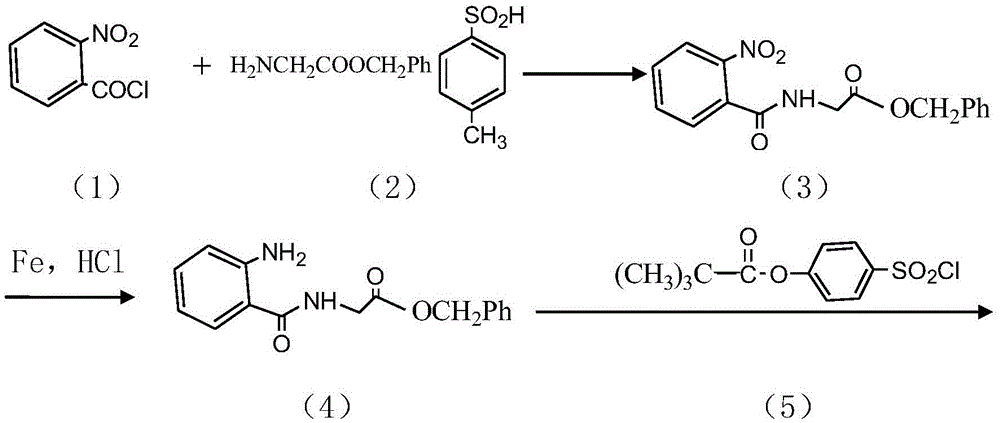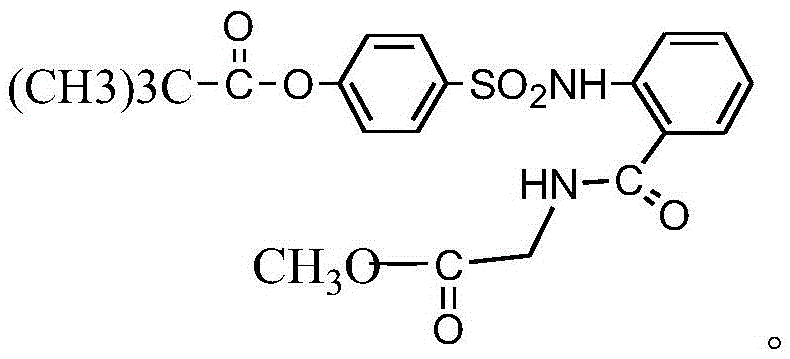A kind of synthetic method of sivelestat sodium
A technology for the synthesis of sivelestat sodium and its synthesis method, which is applied in the fields of sulfonamide preparation and organic chemistry, can solve the problems of low iron powder reduction yield, low safety factor of industrial production, easy poisoning of palladium carbon, etc. The effect of simple recycling, shortened synthesis process route, and mild reaction conditions
- Summary
- Abstract
- Description
- Claims
- Application Information
AI Technical Summary
Problems solved by technology
Method used
Image
Examples
Embodiment 1
[0020] A kind of new synthetic method of sivelestat sodium that the embodiment of the present invention 1 proposes, comprises the following steps:
[0021] Take 1 mol of acid chloride (acyl chloride is obtained by reacting with thionyl chloride after acylation with amino benzoic acid as raw material), 500 ml of non-polar organic solvent, 1.0-3.0 mol of alkali acid-binding agent, glycine methyl ester hydrochloride Put 1.0-2.0mol and appropriate amount of amide catalyst into the reaction container in turn, and react at 25-30°C for 5-7h; pour the reaction product into 300ml of hydrochloric acid with a mass fraction of 18-20wt%, and stir at 20-30°C Reaction 1.8-2.5h;
[0022] After the reaction, the organic layer was separated by standing, the water layer was N-benzyloxycarbonylmethyl-2-aminobenzamide glycine solution, the pH value of the water layer was adjusted with dilute alkali until pH=7±0.1, after stirring for a period of time The pH value of the re-measurement remains unch...
Embodiment 2
[0026] A kind of new synthetic method of sivelestat sodium that the embodiment of the present invention 2 proposes, comprises the following steps:
[0027] S1. Put 50 grams of acid chloride (8), 500 ml of dichloromethane, 65 g of triethylamine, 35 g of glycine methyl ester hydrochloride (9), and an appropriate amount of amide catalyst into the reaction vessel in turn, and react at 28° C. for 6 hours; the reaction ends Finally, pour the reaction product into 300ml of hydrochloric acid with a mass fraction of 20wt%, and stir and react at 25°C for 2h; let it stand, and separate the organic layer, and the water layer is N-benzyloxycarbonylmethyl-2-aminobenzamide glycine (10) solution, the pH value of the water layer is adjusted with dilute alkali until pH = 7 ± 0.1, and after stirring for a period of time, the pH value of the retest remains unchanged, and the light yellow solid is filtered out, recrystallized with absolute ethanol after drying, and dried The off-white solid obtain...
PUM
 Login to View More
Login to View More Abstract
Description
Claims
Application Information
 Login to View More
Login to View More - R&D
- Intellectual Property
- Life Sciences
- Materials
- Tech Scout
- Unparalleled Data Quality
- Higher Quality Content
- 60% Fewer Hallucinations
Browse by: Latest US Patents, China's latest patents, Technical Efficacy Thesaurus, Application Domain, Technology Topic, Popular Technical Reports.
© 2025 PatSnap. All rights reserved.Legal|Privacy policy|Modern Slavery Act Transparency Statement|Sitemap|About US| Contact US: help@patsnap.com



